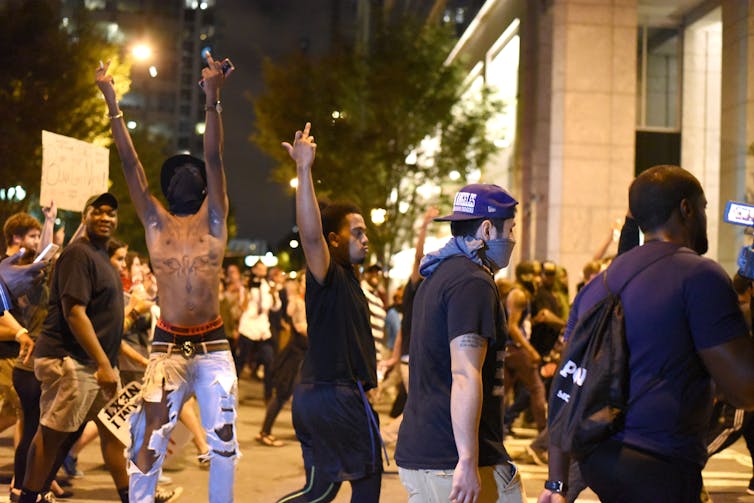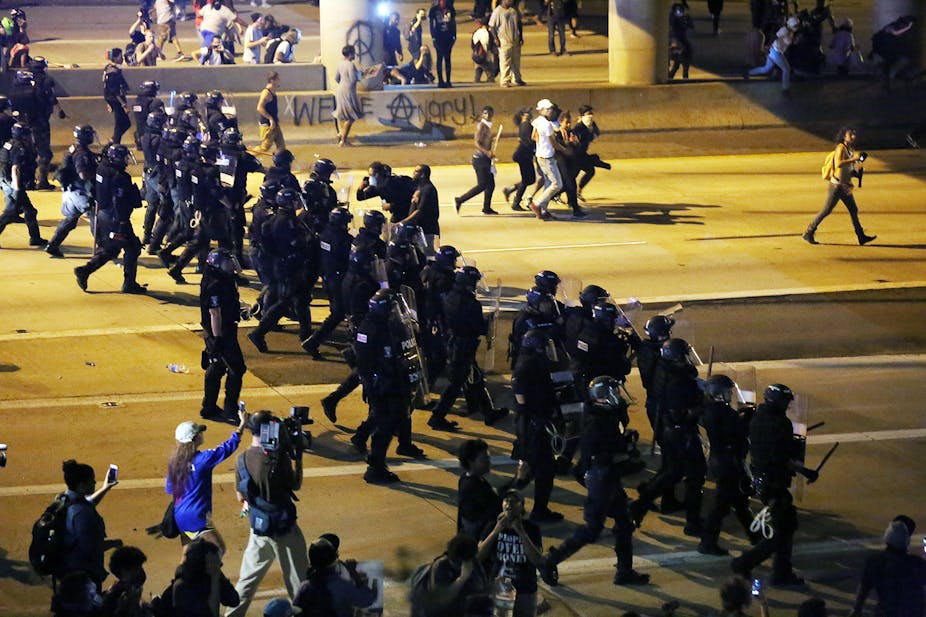After a summer during which the issue of police violence against black Americans has dominated the headlines, it was just another day, another shooting. On September 20, 43-year-old Keith Scott was shot dead by police in a parking lot in Charlotte, North Carolina in disputed circumstances.
The police’s version of events is that he had a gun and did not respond to clear and repeated instructions to drop it. According to onlookers, he was not holding a gun, but a book. Nobody disputes that he had not committed a crime, or that police were not seeking him – they were in the parking lot searching for another individual.
I’m currently working in the US researching the issue of death after police contact. Many people I’ve interviewed have told me these events are “just business as usual”, before saying: “we’re sick and tired of business as usual”. Lately the focus has been on police shootings of citizens in Tulsa, Oklahoma; Columbus, Ohio; and, of course, Charlotte.
Just a few weeks before the latest protests and violence, my research took me to Charlotte to interview four people who’d had relatives shot dead by the police in the past eight years. Much of what they said resonated with me as events unfolded after Scott was killed.
First, some context. Since 2014, the Guardian’s project The Counted database, has kept a tally of citizens who have died after police contact in the US. It recorded in excess of 1100 such deaths in 2015. (Only one citizen in the whole of England and Wales was shot dead by police in 2015.)
In October 2015 James Comey, director of the FBI admitted that federal authorities did not know the number of deaths after police contact, a fact he conceded was “embarrassing”.
The number of black and Native American people killed is significantly disproportionate to the number of white people. According to an analysis by the Washington Post, white people make up about 62% of the US population, only about 49% of people killed by police officers are white; conversely, while just 13% of the US population is African-American, 24% of those fatally shot and killed by the police are black. Black Americans are therefore about 2.5 times as likely as white Americans to be shot and killed by police officers.
According to The Counted, 26 people in North Carolina died after police contact in 2015; that number has already been matched in 2016.
Many of the exact details in the Keith Scott case are disputed, and I don’t intend to join in the speculation. What I want to do is highlight some persistent issues in these cases and draw connections with the interviews I did with family members in Charlotte.
Everyday violence
The son of one of the women I spoke with in Charlotte had been shot twice in the back by the police in Charlotte in 2008. He had committed no crime and was handcuffed on the sidewalk as he lay dying; the officer who shot him went unpunished.
Towards the end of our interview, she gave an almost prophetic statement when the talk turned to making stronger links between the black community and police in Charlotte – a common theme in official discourse in the US:
I am not going to let my grandson build a relationship with someone that was supposed to protect his dad and killed him. I am going to honour my son’s name through his son and he won’t ever be rubbed on the head and patted like a dog at the cook out that we have for the police officers in the community to get together. Because 30 minutes later the community are going to be mourning another child that got killed by a police officer, just watch and see, because there is nothing being done here in Charlotte, North Carolina to these police officers.
This perfectly articulates both the resentment and anger about the lack of accountability for these shootings – and also reminds that for many Americans, the possibility of dying after police contact is a part of day-to-day life.

The police’s dire record of communication and transparency resurfaced again and again in my interviews. Too often, even routinely, police simply do not take the initiative to inform families and the wider community about the details of their friends and family members’ deaths, a fact underlined by the ongoing dispute over the camera footage of Keith Scott’s shooting.
One mother told me she had only found out her son was dead when his killing was announced on the 10am morning news – he had been shot by police nine hours previously. Another saw her son’s autopsy report in the newspaper before receiving it in the mail. Another had to bury her son without his heart because it had been retained by the medical examiner. Too often the message is that the families of the deceased and the deceased themselves just don’t matter.
Poor transparency goes hand in hand with a communication problem. After the death of Keith Scott brought thousands of Charlotteans out on to the streets, the mayor announced that a protester had been shot dead. On Thursday morning he was suddenly alive. By Thursday evening he was dead “again”. When asked whether the gun allegedly recovered from the ground near Keith Scott’s body was loaded, the lead spokesperson for Charlotte police answered: “we don’t know.”
How could the police not know such a thing? Given what many of the people I spoke to experience every day, it’s not unreasonable to presume they do know and simply don’t wish to share that information.
The cycle continues
Faced by angry protests about another black death after police contact, the authorities in Charlotte fell back on the same response we’ve seen time and again: declare a state of emergency, deploy the national guard, fire tear gas and rubber bullets at demonstrators.
This meshes with a couple of themes that have persistently surfaced in my interviews. Firstly, the police do not routinely use de-escalation to establish order. Instead, they use force – a perverse method, given that it was the use of force that provoked disorder in the first place.
Secondly, the police effectively operate as a paramilitary force. Police theoretically have a range of options when faced with confrontations, starting from communication, then running through containment, the use of pepper spray, batons and/or tasers all the way up to using guns. And yet the use of force, including lethal force, is often their first choice – which leaves them with nothing up their sleeve.
Guns should be weapons of last resort, but they are too often used as the primary tools of law enforcement. It’s not in the least surprising that there is public outrage about these shootings given the frequency with which they occur and the racial dimension involved.
In the end, violence begets violence, and it’s hard to foresee when the cycle might be broken. These deaths are reported as “tragedies”, but the real tragedy is that society still fails to grapple with the conduct of police, the way they use their guns – and the effects of racism.

